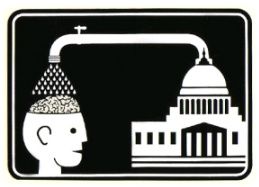| « SAMSON AND THE 2ND NAKBA - A SHORT STUDY OF THE JEWISH HERCULES | Are Zionists violating Norwegian sovereignty by terrorizing a Palestinian Norwegian citizen in Norway? » |
US Democracy, Progressivism , and Brand Building

By Joaquin Posted by Michael Collins
Analysts for the political parties create segmentation labels like NASCAR Dads, progressivism, liberal, green, fiscal conservatism, etc for purposes having to do with the party's brand building and marketing campaigns. This process is very similar to that on which Corporate America spends so much time and money. An institution's brand and its knowledge of its customers are the Corporate family jewels. So it is with political parties.
It is important to understand that public labels of marketing segments are, in and of themselves, marketing messages; a kind of voice. It is unlikely that sophisticated political analysts segment their market with these terms; that is a statistical process that involves correlation of reactions to messages. The correlation around the messages enables the analysts to refine the party's voice to a particular segment. It is a sophisticated process that requires a solid knowledge of statistics and modern marketing techniques.
As previously mentioned, the public labels are part of a message, part of the voice; they are a kind of branding. These brands have a powerful affect because the customer, or voter in this case, actually attach themselves to the brand. A good example of this in the business world is the Whole Foods Brand where the ambiance, inventory, and staff define the brand as healthy, liberal, etc such that a certain segment of the population identify with it and attach themselves to it; preferring to shop for groceries of this brand. Yet, in their analysis, Whole Foods marketing staff likely did not think of their market segment in the terms of the message.

The marketer's are segmenting according to income, demographic etc and then searching for a message that appeals to a particular segment. By identifying strongly with a brand, Whole Food's customers actually begin to isolate themselves from the shoppers at Safeway, Krogers, etc. Because of this, a very strong brand can actually work like a wedge splitting customers off and isolating them from other brands and even the unhealthy effect of isolating one segment from other segments of the population.
So it is with the parties who segment the electorate into groups that can be motivated to vote in different ways. Political marketing analysis takes into account the expense of customer acquisition i.e., the cost of bringing people to the polls. The better the segmentation; the better costs can be understood and budgeted often referred to as channels; again, this is no different than many retailing marketers. In this way, the parties have carved up the electorate like a roast; looking at demographics, income, correlating to messages. Only then is a brand like "progressive" crafted so that a certain segment can identify with it and attach themselves to it. Once a brand is identified, it is given a voice that is refined over time.
The two parties are constantly at each others market segments; crafting their own voice, re-branding and possibly trying to steal away chunks or demoralize them.
To the extent that we allow ourselves to think ourselves part of a brand like progressivism, we are building the strength of that brand. This creates a box of a kind which is sometimes hard to think outside of. Just ask yourself, "Do I believe in progressivism?". If the answer is yes then mission accomplished; branding complete. Believing in individual propositions shared by progressives is one thing but believing in progressivism is another.
This business of carving the electorate into more and more specific segments is a problem because it becomes hard to get important things done. The new health insurance reform, Obamacare, is a poignant example. A mediocre solution was a foregone conclusion because any strong clean solution would harm or even destroy certain segmentation around the Democrat's brand. The Republican's certainly tried to use even the weak solution to attack the Democrat's brands. In this analysis, it is not only corruption but marketing that is keeping good governance away.

The United States has a two party system because of plural elections; therefore, the two parties own all of the electorate branding. In their big tents, neither party can well serve all of their segments.
There is another curious property of brands that we should all be aware of. A powerful brand like Reaganism can take on a new property when it persists across generations. Those who grew up identifying with the label and become politically active create a kind of feedback loop. It is an aging process that causes an institution like the Republican party to gradually become its marketing messages. It happens to business's and religious institutions too; they gradually forget what they were all about and become something else entirely.
First published in The Agonist
No feedback yet



